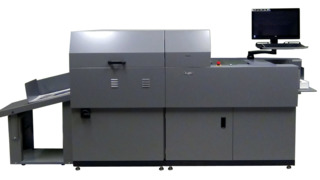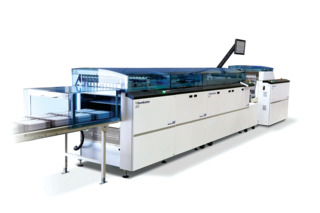Hot Tech in Value-added, Digital Print Finishing/Mailing
Improved workflow and embellished inkjet output lead the way into Q2 2019 and beyond.

With Hunkeler Innovation Days 2019 now in the rear-view mirror, what can print service providers (PSPs) expect in the digital finishing sector for the rest of this year? From more integrated and highly automated back-end workflow solutions -- even touch-less workflow – to textured special effects such as foil embossing and raised UV coatings, the clock is no longer the limit in what our industry once called the bindery.
In the digital world, print finishing’s worn reputation as a cost center indeed may have shifted. “Finishing is now viewed as an area of opportunity,” contends Don Dubuque, marketing director at Standard Finishing Systems. “With the right equipment, [print] providers can differentiate themselves and add value to their finished products. Die cutting, embossing/debossing and other finishing touches allow greater customization and flexibility than ever before, so creativity and top-quality products can shine.”
Allow us to, well, embellish. Embellishing means to make something more attractive by the addition of decorative details or features. In the printscape, embellishment can add value. When found in the mailstream, it can get people to open up and read items like postcards, self-mailers and door hangers (election season is here!). High quality trumps high quantity in today’s direct-mail arena, and the ability to create new offerings changes the game.
“Everything is targeted,” says Doug Sherwood, national sales manager for print-finishing provider Rollem USA. “The equipment allows us to do more for customers. We produce fewer pieces that get better results: response rates between 10% and 15%!” Citing one such highly targeted example, “A pet company can diecut the shape of actual dog breeds” to capture the attention of known pet owners in their database, he illustrates.
“We all know the days of 10-million [print] runs are over,” Sherwood notes. “Traditional mailing houses are down. There are not a lot of big jobs anymore.” And because production runs are smaller, “direct-mail printers need more business and more customers. The end-goal for them is one-stop shopping. New technologies allow them to appeal to vertical markets, such as realtors or the medical industry,” he adds.
It should not come as a surprise that direct mailers still are looking for ways to cost-effectively produce pieces that stand out in mailboxes. Such differentiation could come by way of “greater personalization, more varied and challenging substrates, embossing/debossing and other finishing touches,” says Dubuque of Standard Finishing. “Or it could come from interesting shapes made possible with die-cuts and perforations.
“With these more intricate pieces, production can sometimes pose a challenge,” Dubuque continues. “Printers who can find ways to streamline the production process from creation to finishing will be able to take on more complex jobs, provide quicker turnaround and earn higher margins.” In the direct mail arena, features such as dynamic perforating, punching and die- cutting can add significant value.
Sherwood, who has been at Rollem for 23 years, remembers when “it used to be all squares and rectangles: postcards, mailers, business cards, tip-on cards -- anything that ran on a square press sheet that you could take and complete and finish it. But that has changed. Digital production allows for more creativity because you can orient product on the back end.”
Workflow Unclogs the Bottleneck
In terms of condensing production time, Duplo USA Corp. took a step in the faster workflow direction in January, when it announced a partnership with EFI (Electronics For Imaging, Inc.) at the latter’s annual Connect User Conference. The time-saving integration focuses on EFI Fiery digital front ends with workflow automation software and Duplo’s DDC-810 Raised Spot UV Coater. EFI and Duplo customers can now complete seven manual file preparation steps in one step, including creating separate CMYK and spot UV files, page impositioning, applying of registration marks and barcodes, and submitting CMYK and spot UV files to a Fiery-driven printer and the DDC-810, respectively.
The Fiery integration also leverages existing Duplo barcode support recently implemented for additional finishing on Duplo DC-746 or DC-646 Slitter/Cutter/Creasers. PSPs can save substantial finisher set-up time by using a barcode produced by Fiery Imposesoftware to automate the set up. “We have taken the complicated step of digital finishing and simplified it through EFI’s JobFlow prepress workflow,” explains Rick Salinas, sales director for Duplo’s Midwest Region. “This process can cut the steps in finishing by more than 50% in many cases.”
Duplo invented the slit/cut/crease market, Salinas points out, “and we lead the market with over 2,000 installations -- more than all competitors combined. This new partnership will help our existing and new installations take finishing to the next level.”
Outside the higher-volume book production market, such finishing innovation has been a long time coming, according to Andy Fetherman, VP of sales and technology at Muller Martini. “Our high-speed inkjet web finishing solutions have been producing commercial-quality books for more than 18 years,” Fetherman says. “Muller Martini was ahead of our time” in what then was still a toner-based printing world. “It took time for the market to catch up” -- and it has! “There are no more sacrifices for digital finishing,” he notes, adding that some of his firm’s web-finishing devices can now operate at speeds up to 1,000 feet per minute (fpm).
Standard offers the extendable Hunkeler Workflow Manager (HWM), a modular platform for workflow management, job set up, production statistics, data interfacing and service tools. HWM is a major step in the advancement of automation, according to the North American distributor, with fully automated registering, and plug-ins for job edition and production set up for cutting, stacking, and dynamic perforating and punching -- eliminating much manual set up of the line. Web inspection and item tracking features can be integrated to ensure smooth and consistent document production.
Fetherman refers to book finishing workflow as “the next frontier,” and Muller Martini, too, is active in this space. Its Connex system takes full advantage of automation. “There are file-to-print workflow solutions out there, but few if any are file-to-finished product,” he explains. “And that’s what we are offering through Connex.”
Other Tech Trends in Digital Print-finishing
The dreaded “bindery bottleneck” can extend beyond workflow software, of course, and into machinery. While older equipment probably is paid for, “big mailing lines are difficult to run,” acknowledges Rollem’s Sherwood. Maintenance can be challenging, often requiring a “MacGyver” handyman to fix and operate vintage machinery.
Plus, “it has become harder in our industry to find skilled workers,” he says. “I can hire a guy now for 20% to 40% less salary. I know a customer who hired a guy who sold cars.” So, more commercial printers are bringing mailing in house. The postpress equipment lends itself to this trend, Sherwood points out, because print owners “can train a guy and run it [themselves]. “The finishing side used to be more segmented, but now there’s a lot of cross-over.”
Owners are realizing that they need to catch up with the times, Sherwood adds, “that there are ways to automate and improve [operating efficiency]. Running equipment with two people versus five minimizes labor and reduces costs.”
Standard’s Dubuque observes: “We will continue to see trends toward shorter runs, and greater customization and intricacy in finished pieces. On one hand, there is greater demand than ever for variety and complexity in applications, but finishing equipment must also be able to keep up with the high-speed inkjet presses on the market today. Printers must be able to handle greater personalization, a wide array of substrates, unique shapes and other challenges.”
Today’s postpress hardware needs to keep pace with direct-mail and other production demands. To meet the requirements of digital commercial printing, Hunkeler has developed its Generation 8 (Gen8) product line, which won a “Must See ’Ems” award in 2017 and is sold in North America by Standard Finishing Systems. Gen8 machines were designed with full-color inkjet applications in mind, Standard says. Its modules support substrates from 27-lb. text to 12-point card as well as the smallest finished sheet format on the market (5.5” long x 4” wide), ideal for full-bleed postcards. In addition, with the new LS8-30, sheets as large as 22.5” x 30” (B2+ format) can be perfectly stacked.
At the quadrennial PRINT 18 equipment exhibition in Chicago this past fall, Standard showed Hunkeler’s Gen8 in two unique integrated solutions. A Roll-to-Fold Solution, ideal for direct mail, featured the Horizon T-566 Folder, as well as the Hunkeler DP8 Dynamic Perforator, WM8 Web Merger, and CS8-II Chip-out Rotary Cutter. The second line was a combination solution showing Gen8 Roll-to-Stack in-line with the Horizon StitchLiner 6000 Saddlestitcher. Both configurations demonstrated the hallmarks of Gen8: greater automation, a wider range of formats and paper weights, and increased speeds (up to 600 fpm) and web width (22½ inches).
Also at PRINT 18 Rollem showed its Insignia diecutters, Mailstream inline folders/gluers and Jetream XY automated, two-directional slit/score/perforate systems. For die-cutting applications beyond the packaging segment, its Insignia line is available in four different configurations for sheet sizes including 13x19” (B2) up to 24x30”. “We can even diecut up to 30-point stock – sticker material and laminated cards, [thin] credit cards,” says Sherwood. Die changeovers in 90 seconds are conducive to smaller runs, he notes.
In addition to integrated solutions, multi-function machines with high levels of automation and versatility have become essential. These systems can perform several finishing processes, allowing for a vast and varied range of output possibilities from a single machine. For instance, the Standard Horizon SmartSlitter can perform slitting, creasing and perforating all in one pass. It also has advanced functionality that allows T-perf’s and L-perf’s for a wider range of applications -- even on heavier, glossy stocks. The Standard Horizon RD-4055 Rotary Die Cutter can die-cut, kiss-cut, crease, perforate, slit, hole-punch and round-corner in one process, creating unique shapes on a range of substrates while maintaining cost-efficiency.
“Anytime there is an opportunity to eliminate or reduce touch-points and labor, there is a benefit to PSPs,” Dubuque says. “Trying to achieve this has led to multiple pieces of hardware being combined into single lines, removing the need for manual intervention between steps and maximizing productivity.”
Eliminating multiple steps is critical, Rollem agrees. The manufacturer emphasizes a multi-function concept wherein machines can have the capability of performing seven, eight or nine functions at the same time. “We ran the folder/gluer behind the die-cutter at the PRINT 18,” says Sherwood. “It’s all about flexibility, streamlining applications and offering system configuration options.” Another example: Its Mailstream solution has an eight-foot mailing table on which inkjet addressing can be done. “You can add label units, too,” he notes. And the Jetstream is available with four different feeders and three to four different deliveries.
Back on the book side, further market penetration for Muller Martini can be seen in the hard-cover space. At Innovation Days last month it demonstrated the Vareo perfect binder, configured with an end-sheet tipper, making hard-cover book blocks.
Duplo, meanwhile, sees digital packaging as a large growth area in the second half of this year and beyond. “With on-demand manufacturing and short-run package mail pieces, this segment needs to automate,” Salinas says. “We see the future expanding into automated die-cutting, and new introductions to our slit/cut/crease line that can fill this packaging and mailing needs.”



